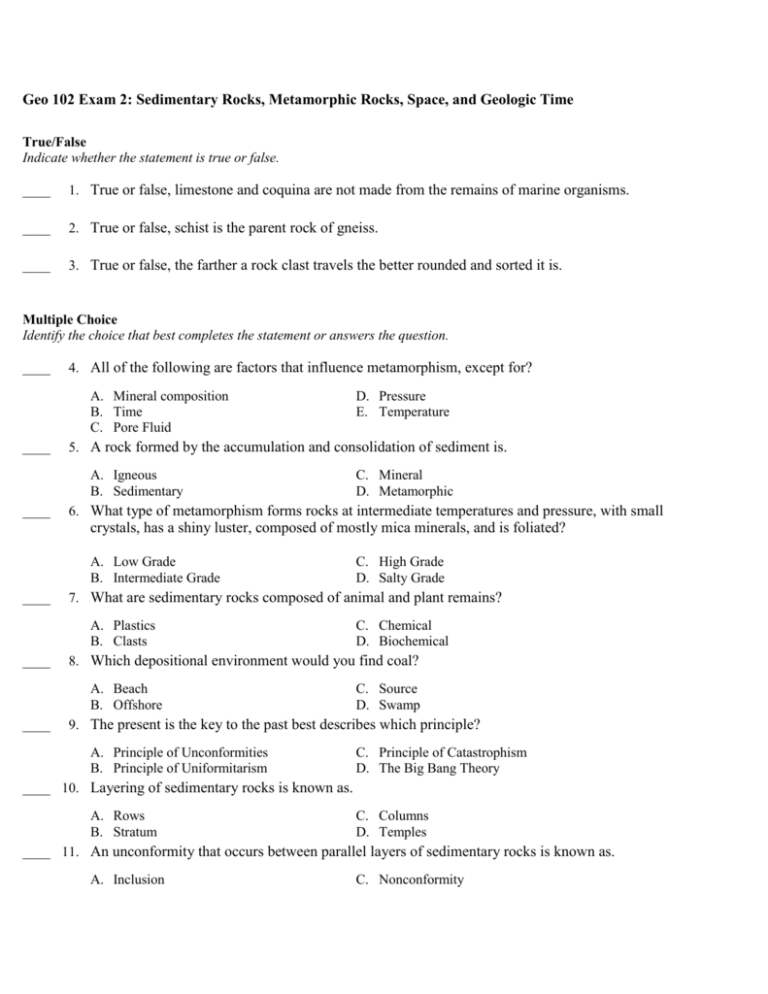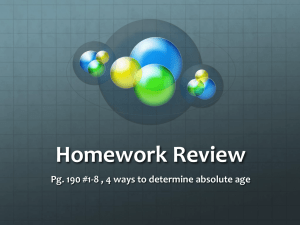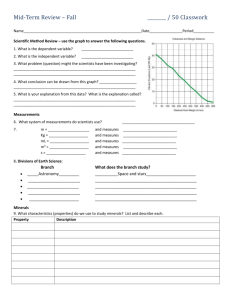Geo 102 Practice Exam 2 (New Version)
advertisement

Geo 102 Exam 2: Sedimentary Rocks, Metamorphic Rocks, Space, and Geologic Time True/False Indicate whether the statement is true or false. ____ 1. True or false, limestone and coquina are not made from the remains of marine organisms. ____ 2. True or false, schist is the parent rock of gneiss. ____ 3. True or false, the farther a rock clast travels the better rounded and sorted it is. Multiple Choice Identify the choice that best completes the statement or answers the question. ____ 4. All of the following are factors that influence metamorphism, except for? A. Mineral composition B. Time C. Pore Fluid ____ 5. A rock formed by the accumulation and consolidation of sediment is. A. Igneous B. Sedimentary ____ D. Pressure E. Temperature C. Mineral D. Metamorphic 6. What type of metamorphism forms rocks at intermediate temperatures and pressure, with small crystals, has a shiny luster, composed of mostly mica minerals, and is foliated? A. Low Grade B. Intermediate Grade ____ 7. What are sedimentary rocks composed of animal and plant remains? A. Plastics B. Clasts ____ C. Chemical D. Biochemical 8. Which depositional environment would you find coal? A. Beach B. Offshore ____ C. High Grade D. Salty Grade C. Source D. Swamp 9. The present is the key to the past best describes which principle? A. Principle of Unconformities B. Principle of Uniformitarism C. Principle of Catastrophism D. The Big Bang Theory ____ 10. Layering of sedimentary rocks is known as. A. Rows B. Stratum C. Columns D. Temples ____ 11. An unconformity that occurs between parallel layers of sedimentary rocks is known as. A. Inclusion C. Nonconformity B. Disconformity D. Unconformity ____ 12. How old is the universe? A. 4.6 billion years B. 13.7 billion years C. 4.6 million years D. 13.7 million years ____ 13. How old is the Earth? A. 4.6 billion years B. 13.7 billion years C. 13.7 million years D. 4.6 million years ____ 14. Below which temperature are most minerals stable with little to no metamorphism (Temperatures are in Celsius)? A. 200 B. 300 C. 150 D. 250 ____ 15. Above what temperature will the reaction rate increase as temperature increases and minerals begin to form (Temperatures are in Celsius)? A. 200 B. 300 C. 500 D. 150 ____ 16. An unconformity that occurs between lower rocks which have been tilted and then eroded with overlying sedimentary rock layers is. A. Unconformity B. Nonconformity C. Disconformity D. Angular unconformity ____ 17. Which type of metamorphism occurs where there is high heat, low pressure, and the rocks are in contact with magma? Nonfoliated rocks are found here. A. Regional B. High Grade C. Burial D. Contact ____ 18. Changes that occur to a rock while it is solid and does not melt is known as. A. Lithification B. Recrystallization C. Crystallization D. Foliation ____ 19. A surface between rock layers that represents missing time and occurs due to erosion or non- deposition is known as. A. Unconformity B. Disconformity C. Nonconformity D. Inclusion ____ 20. What are sedimentary rocks formed by minerals precipitating from solution (an inorganic process only)? A. Biochemical B. Chemical C. Delicious D. Clastic ____ 21. What type of metamorphism occurs in areas of mountain building along convergent plate boundaries and the rocks become foliated by differential pressure? A. Low Grade B. Contact C. Regional D. Burial ____ 22. An unconformity that occurs between eroded igneous or metamorphic rocks and overlaying sedimentary rock layers is. A. Angular unconformity B. disconformity C. inclusion D. Nonconformity ____ 23. What are sedimentary rocks composed of broken fragments of rock produced by weathering? A. Plaster B. Clasts C. Biochemical D. Chemical ____ 24. Above what temperature will some minerals begin to melt and transition into igneous rocks? A. 450 B. 300 C. 600 D. 200 ____ 25. What type of metamorphism forms rocks at high temperatures and pressure, with large crystals, is composed of mica minerals, and is foliated? A. Good grades B. Intermediate grade C. High grade D. Low grade ____ 26. All of the following are examples of sedimentary rocks formed chemically in terrestrial environments, except for? A. Limestone B. Gypsum C. Chert D. Halite ____ 27. All of the following are reasons why Earth is unique from other planets, except for? A. Life B. Tectonic processes C. Only planet that is differentiated D. Only planet with three states of water ____ 28. Which of the following is a sedimentary rock that forms biochemically in a marine environment? A. Carbonates B. Evaporites C. Breccia D. Shale ____ 29. What type of metamorphism forms rocks at low temperatures and pressure, with microscopic crystals, have a dull luster, are composed of clay and mica minerals, and are foliated? A. Low grade B. Middle of the road C. High grade D. Intermediate grade Matching Match the following depositional environments with the correct sedimentary rock A. Basin/Playa E. Swamp B. Near Source F. Off Shore C. Reef G. Downstream D. Beach ____ 30. Lithic Sandstone ____ 31. Evaporites (Halite, Gypsum, & Chert) ____ 32. Siltstone ____ ____ ____ ____ ____ ____ ____ ____ 33. 34. 35. 36. 37. 38. 39. 40. Shale Arkose Sandstone Breccia Coal Conglomerate Limestone Coquina Quartz Sandstone Match the following principles of geologic time with their description. A. Original Horizontality D. Inclusions B. Superposition E. Cross cutting relations C. Unconformities F. Fossil correlation ____ ____ ____ ____ ____ ____ 41. 42. 43. 44. 45. 46. Based on evolution, relies on superposition, and when a species becomes extinct is does not reappear. Rock layers or sediments deposited on top of other sediments or rock layers are always younger. A surface within a sequence of layers where no deposition and erosion took place. A rock layer is always older than a feature that cuts through it. Sediments deposited in horizontal layers When a rock fragment is found within another rock type. The rock fragment is older. Match the following metamorphic rocks with their parent rock: A. Marble B. Slate C. Gneiss ____ ____ ____ ____ ____ ____ 47. 48. 49. 50. 51. 52. D. Phyllite E. Schist F. Quartzite Quartz Sandstone Shale Slate Phyllite Limestone Schist or Volcanic Rock Match the following space rock with the appropriate statement A. Asteroid D. Meteorite B. Comet E. Meteoroid C. Meteor ____ ____ ____ ____ ____ 53. 54. 55. 56. 57. A small, sometimes active, object made of ice, dust, and gas When a meteoroid has entered the Earth’s atmosphere and vaporizes (aka: shooting star) A small particle from a comet or asteroid that orbits the sun (does not enter Earth) An inactive rocky body that orbits the sun A meteoroid that survives the passage through Earth’s atmosphere and lands upon Earth’s surface Short Answer 58. What theory describes the formation of the solar system, and what are the three major steps in this process? 59. What are sediments? 60. What is the difference between a foliated and nonfoliated metamorphic rock? 61. Define radioactive decay. 62. What are Earth’s three major cycles and why are they important? 63. What are the three types of metamorphism and their differences? 64. What is planetary differentiation, and how is it arranged. 65. What theory describes the formation of the universe? 66. Name the Terrestrial and Jovian Planets. 67. What are the three types of sediments? 68. What is the difference between a transgression and a regression in sea level? 69. How is coal made? 70. What are the three types of systems and what are their differences? 71. What is the difference between relative and absolute dating? 72. What are the heat and pressure conditions for regional metamorphism? 73. What are Earth’s four major subsystems? 74. What are the different ways to sort sediments? 75. Which sedimentary rocks are cemented together? 76. What is the difference between poorly and well sorted sediments? 77. Which sedimentary rocks are compacted together? 78. Clastic sediment sizes are. 79. Why are contact metamorphic rocks nonfoliated? 80. What are the heat and pressure conditions for burial metamorphism? 81. Define an isotope. 82. Name and describe one failed theory for dating the Earth. 83. What is the difference between alpha and beta radioactive decay. 84. What is the main difference between a breccia and a conglomerate? 85. Define metamorphism. 86. What are three ways that sediments are created? 87. What is the difference between a terrestrial and Jovian planet? 88. How do you name a clastic sedimentary rock? Problem 89. What is the half-life of an isotopic pair if the sample is 2 million years old and contains 625g of parent and 9375g of daughter isotope? 90. What is the parent/daughter ratio of a sample of radiogenic material if the original sample was 200g. and 3 half-lifes have passed. If the half-life is 20,000 years. How old is the sample?








